by Conrad Meertins | Nov 6, 2024 | Uncategorized

Could skipping an appraisal save you money—or cost you thousands? In a bid to boost home affordability, Fannie Mae and Freddie Mac recently announced expansions to their appraisal waiver programs, starting in the first quarter of 2025.
This move could allow more buyers to bypass traditional appraisals, potentially saving hundreds in upfront costs and speeding up the closing process. Designed to assist first-time and low- to moderate-income buyers, this initiative has already saved borrowers over $2.5 billion since 2020, according to Fannie Mae.
But while the program may offer an easier path to homeownership, it raises critical questions for buyers. Can bypassing a full appraisal expose you to risks that could hurt your financial future?
What is the Announcement?

Fannie Mae and Freddie Mac, the government-sponsored enterprises backing most U.S. mortgages, are expanding the eligibility for appraisal waivers. These waivers, designed to reduce costs and simplify the process, allow certain buyers to purchase homes without a traditional appraisal. Here’s a quick breakdown of the options:
Value Acceptance (formerly appraisal waivers): Uses data modeling to confirm the property’s value and sale price.
Value Acceptance + Property Data: Involves a trained professional collecting data on the property’s interior and exterior.
Automated Collateral Evaluation (ACE): Freddie Mac’s program that uses proprietary models and public records to assess property values.
ACE + Property Data Report (PDR): Combines Freddie Mac’s models with on-site property data collection.
With these changes, loan-to-value (LTV) ratios for waiver eligibility are also increasing, allowing up to 90% LTV for standard waivers and up to 97% for inspection-based waivers. For many buyers, this expanded access means greater flexibility and faster closings.
What Should Buyers Know?

While appraisal waivers can offer benefits, it’s essential to consider the risks. Here are a few crucial points:
Overpaying: Without an independent appraisal, there’s a risk you might pay more than the property’s true market value. Lender models might miss local nuances, causing buyers to unknowingly overpay.
Limited Negotiation: If the lender’s valuation is higher than expected, it might restrict your ability to negotiate a lower price, limiting any wiggle room with the seller.
Missed Issues: An algorithm can’t catch everything. Unlike a traditional appraiser who can inspect the property firsthand, automated data models may overlook physical issues like a weakened foundation or faulty wiring, which could lead to expensive repairs down the line.
Imagine buying a home with an inflated valuation, only to discover costly issues that a standard appraisal might have caught. Waiving an appraisal could mean shouldering unexpected financial strain, especially if you need to sell during a downturn.
It’s important to remember that in 2023, over 31% of American households were already spending more than 30% of their income on housing. Adding hidden property issues could increase that burden even further.
What’s Missing from the Announcement?

While Fannie Mae and Freddie Mac promote the benefits of waivers, here are some points they didn’t mention that buyers should consider:
Conflicts of Interest: Lenders have a vested interest in closing deals quickly and efficiently, which may lead them to prioritize speed over thorough property assessment.
Buyer Responsibility: It’s ultimately on the buyer to ensure they’re paying a fair price. Relying solely on lender valuations can create a “blind spot” in the homebuying process, as lenders focus primarily on their own financial risks.
With rapid price fluctuations—the Federal Housing Finance Agency’s House Price Index increased by over 57% from July 2019 to July 2024—it’s clear that a reliable property valuation is more crucial than ever. Proceeding without a traditional appraisal could leave buyers unprepared to navigate these changes.
How Can Buyers Protect Their Interests?
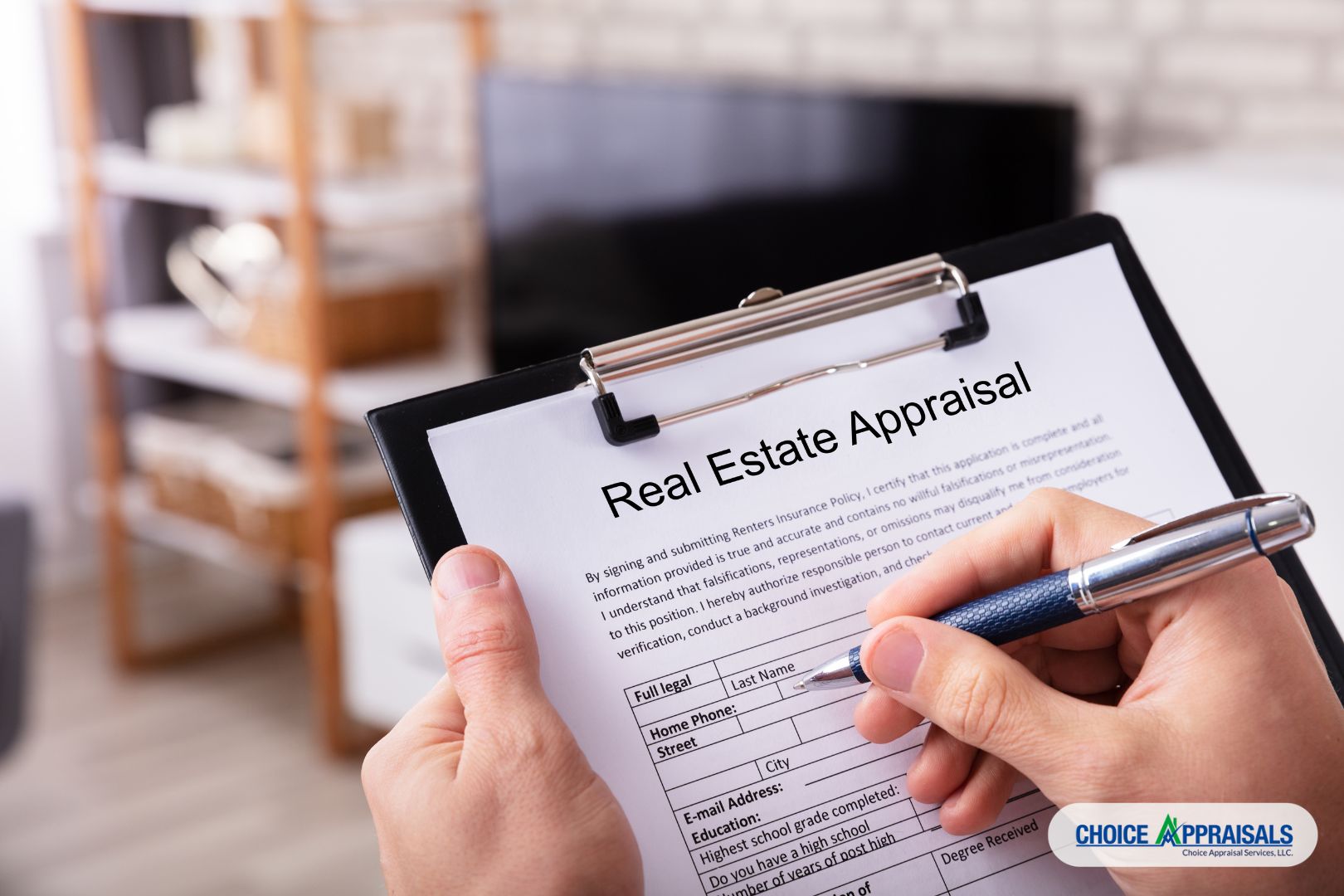
Navigating the appraisal waiver landscape can be challenging, but here are a few key ways buyers can safeguard their investments and make informed decisions:
Consider a Professional Appraisal: An independent appraisal offers an objective, expert valuation that goes beyond automated estimates. Appraisers are trained to assess property nuances and current market conditions, offering peace of mind and protecting buyers from potential pitfalls. This small investment can provide clarity and confidence, ensuring you’re on solid ground with your purchase.
Rely on Local Market Knowledge: Understanding a property’s true market value requires in-depth knowledge of local trends, comparable sales, and potential red flags. Appraisers specialize in this level of detailed market research, bringing a wealth of data to support fair and accurate valuations—especially valuable in a fluctuating market.
Seek Guidance from Experienced Professionals: Appraisers, along with real estate experts, are invaluable allies in the buying process. Leveraging their expertise ensures you have a clear view of the property’s value, equipping you to make decisions with lasting impact.
Conclusion
Appraisal waivers may offer convenience and cost savings, but it’s essential to consider the potential risks carefully. Overpaying, overlooking property issues, or facing an uncertain market could lead to costly setbacks.
A professional appraisal can provide the clarity and assurance buyers need to make informed, confident decisions. The path to homeownership might feel streamlined, but relying on expert guidance and a trusted valuation can help ensure it’s also a secure one.
Want to make confident, informed decisions on your homebuying journey? Visit our blog for expert insights on how a professional appraisal can protect your investment. Whether you’re navigating waivers or just starting, our articles are here to guide you every step of the way
by Conrad Meertins | Sep 30, 2024 | Uncategorized

Are you considering buying or selling a home in Louisville’s MLS Area 6, which includes Buechel, Highview, Okolona, and Fern Creek? Understanding current market trends is crucial for making informed decisions. Let’s dive into how these neighborhoods are faring in today’s real estate landscape.
Current Market Snapshot (as of September 28, 2024)

- Active Listings: 242
- Median Listing Price: $315,900
- Average Days on Market: 56 days
- Median Days on Market: 34 days
These numbers tell an interesting story. With homes staying on the market for nearly two months, buyers may find more room for negotiation, especially on properties listed for 50+ days. Sellers should note that pricing strategy is key in this market.
Price Trends: A Tale of Two Markets

- Median Listing Price (Active): $315,900
- Median Sales Price (Sold): $250,000
- Average Days on Market (Sold): 28 days
- Median Days on Market (Sold): 7 days
The significant gap between listing and selling prices suggests that while sellers are optimistic, buyers are more cautious. However, homes priced right are still moving quickly, often in less than a two weeks.
Supply & Demand: A Clearer Picture

- Current Active Listings: 242 (as of September 28, 2024)
- Total Sold Properties: 2,402 (from January 1, 2023 to September 28, 2024)
Let’s break this down:
- The 242 active listings represent what’s available right now in Buechel, Highview, Okolona, and Fern Creek.
- 2,402 properties sold over the past 21 months, averaging about 114 sales per month.
This suggests strong ongoing demand in Area 6, with current inventory limited compared to the consistent sales rate. It’s a market that favors sellers, but buyers who act decisively on well-priced homes can still find opportunities.
Property Characteristics

| |
Active Listings
|
Sold Properites
|
| Average Size |
1722 sq ft |
1525 sq ft |
Homes currently on the market tend to be larger and relatively newer. This could explain the higher listing prices and longer selling times, as these properties may be at the upper end of the local market.
What This Means for You
For Buyers:
- Be prepared for competition, especially for well-priced homes.
- Don’t hesitate to negotiate, particularly on homes that have been listed for a while.
- Consider the long-term value of larger, newer homes currently available.
For Sellers:
- Pricing is critical. Homes priced right are still selling quickly.
- Be prepared for negotiations, especially if your home has been listed for over 50 days.
- Highlight features that make your property stand out, such as size or recent updates.
Neighborhood Spotlight

Buechel, Highview, Okolona, and Fern Creek each offer unique attractions:
- Buechel: Known for its diverse community and proximity to Bardstown Road.
- Highview: Offers a suburban feel with easy access to downtown Louisville.
- Okolona: Popular for its parks and family-friendly atmosphere.
- Fern Creek: Balances rural charm with modern conveniences.
These varied neighborhoods contribute to the diverse housing options in Area 6, catering to a wide range of preferences and budgets.
Looking Ahead
The real estate market in MLS Area 6 reflects a balance between opportunity and challenge. While inventory is limited compared to recent sales volume, the longer days on market for current listings suggest a shift towards a more balanced market.
For both buyers and sellers, understanding these local trends is key to making informed decisions. Whether you’re looking to buy your first home, upgrade to a larger property, or sell your current house, the diverse neighborhoods of Area 6 offer something for everyone.
Interested in a more personalized analysis of your specific situation in Buechel, Highview, Okolona, or Fern Creek? Don’t hesitate to reach out. We’re here to help you navigate this dynamic market with confidence.
by Conrad Meertins | Jun 24, 2024 | Uncategorized

Ever wondered how appraising a charming Victorian mansion differs from a modern suburban home? Historical properties offer unique challenges and opportunities in the appraisal process.
The allure of these properties lies in their rich history and architectural beauty, making them more than just real estate—they’re pieces of history.
This article delves into the intricacies of appraising historical properties, highlighting the unique factors that affect their value.
From understanding their historical significance to navigating regulatory hurdles, we’ll guide you through the essential aspects of this specialized field.
By mastering the art of appraising historical properties, you’ll be better equipped to preserve their legacy while ensuring accurate valuations. Join me as we uncover the fascinating world of historical property appraisals and equip yourself with the knowledge to navigate this rewarding yet challenging domain.
Understanding Historical Properties

Understanding historical properties begins with recognizing what qualifies them as historical. These properties, often at least 100 years old, possess architectural, cultural, or historical significance.
For instance, a Victorian mansion built in the 19th century may feature intricate woodwork and original stained glass, representing the craftsmanship of its era.
Historical properties are often listed on registers like the National Register of Historic Places, which not only acknowledges their significance but can also provide tax incentives for preservation.
The historical significance can elevate a property’s value, but it also demands careful maintenance and adherence to preservation standards.
Consider the Conrad-Caldwell House in Louisville, KY, an exquisite Richardsonian Romanesque mansion. It stands as a testament to meticulous preservation and historical integrity.
For appraisers, understanding these elements is crucial. It involves assessing not just the physical attributes but also the historical context, making it essential to approach these appraisals with a blend of historical knowledge and technical expertise.
Unique Factors Influencing Appraisal Values

Appraising historical properties involves unique factors that significantly influence their values. Historical significance is a primary factor, as properties associated with notable events or figures can command higher appraisals.
Imagine the birthplace of a famous author or a building pivotal in a historic event—its unique story can greatly increase its value.
Architectural integrity also plays a crucial role. Properties retaining original features like period-specific woodwork, stained glass, or original facades often appraise higher.
Take the Brennan House in Louisville, KY, for example. It’s a prime illustration of preserved Victorian architecture and original furnishings, adding significant value.
Location and context further impact value. Properties situated in well-preserved historical districts or near other landmarks tend to appraise higher. A historic home in Old Louisville, with its prestigious location and historical surroundings, is a perfect example of this.
These unique factors require appraisers to combine historical insight with market analysis to accurately determine the value of historical properties.
Challenges in Appraising Historical Properties

Appraising historical properties presents several challenges. One major hurdle is the lack of comparable properties. Unlike modern homes, historical properties are unique, making it difficult to find similar sales for accurate comparisons.
Imagine trying to find recent sales of an 18th-century Georgian mansion—it’s not easy, and this complicates value estimation.
Condition and restoration needs are also significant challenges. Historical properties often require extensive maintenance and preservation, impacting their appraised value.
The cost of restoring original features, such as hand-carved woodwork or vintage stained glass, can be substantial. Restoring the woodwork in a Victorian home, for example, can cost tens of thousands of dollars.
Regulatory and zoning issues further complicate appraisals. Properties in historical districts may face strict preservation laws limiting alterations. These restrictions can deter potential buyers, affecting market value.
Understanding these challenges is crucial for accurate appraisals, requiring appraisers to blend historical knowledge with practical considerations of maintenance and legal constraints.
Appraisal Methods for Historical Properties
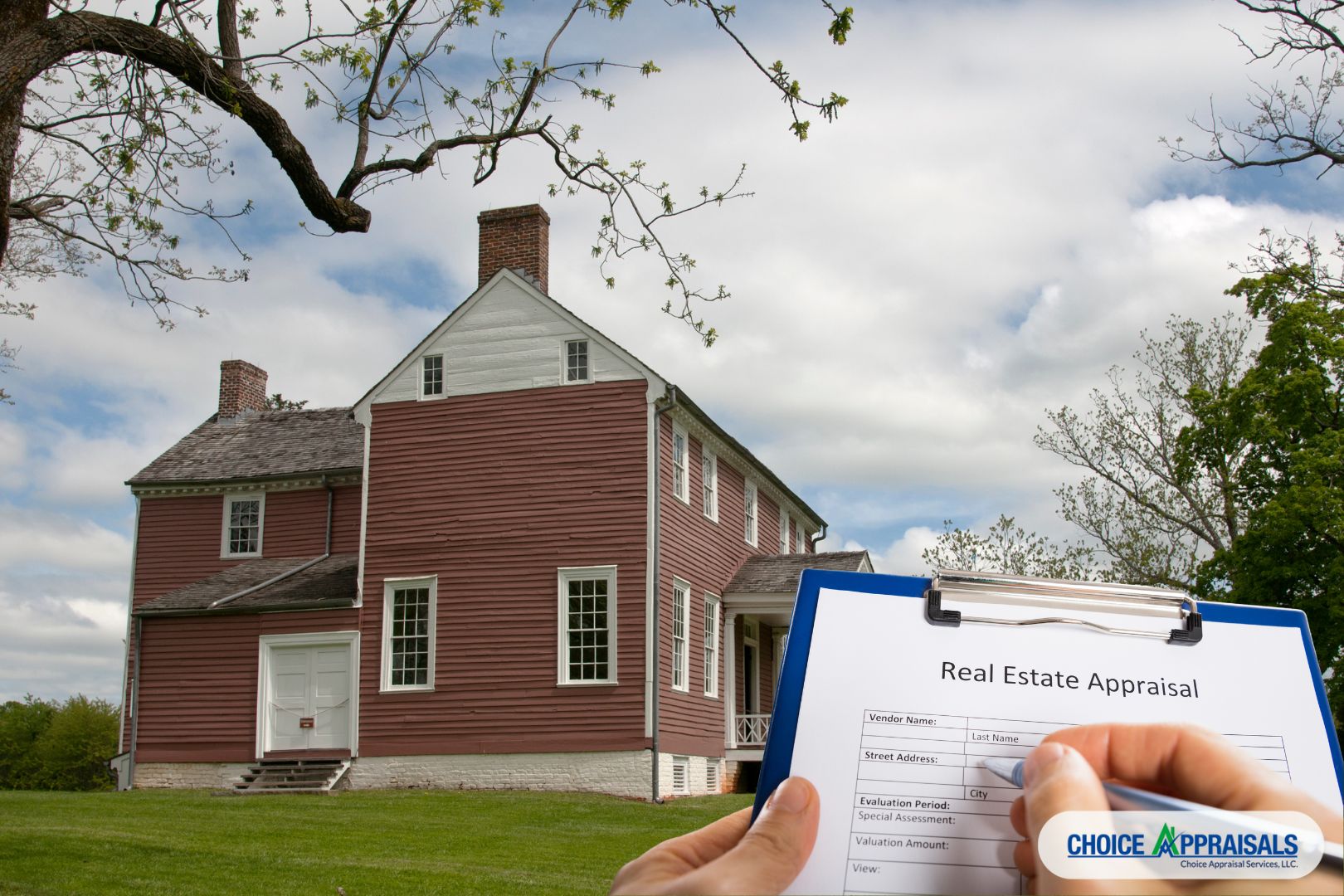
Appraising historical properties necessitates specialized methods to capture their unique value. The Sales Comparison Approach involves comparing the historical property to similar ones that have recently sold, but finding adequate comparables can be challenging.
Adjustments must be made for unique historical features. For example, a Civil War-era house in Louisville might be compared with other historic homes in the area, factoring in its age, condition, and historical significance.
The Cost Approach estimates the value based on the cost to replicate the property, accounting for depreciation. This method is beneficial for properties with significant restorations.
Estimating the cost to restore a Victorian mansion in Old Louisville to its original state helps determine its value by considering both the replacement cost and depreciation.
The Income Capitalization Approach is useful for historical properties generating income, like converted bed-and-breakfasts (if zoning permits). This method assesses the property’s value based on its income potential, factoring in operating expenses and expected returns.
Understanding these appraisal methods allows for accurate valuations, ensuring historical properties are appraised with their unique characteristics in mind.
Best Practices for Realtors Working with Historical Properties

Realtors working with historical properties should follow best practices to ensure accurate appraisals and successful transactions. First, gathering comprehensive documentation is essential. This includes historical records, previous appraisals, and architectural plans. Collaborating with local historical societies can provide invaluable insights and data.
Preparing the property for appraisal involves highlighting its unique features. Ensure that original elements like period-specific woodwork or stained glass are showcased. Addressing necessary repairs while preserving historical integrity can positively impact the appraisal.
Effective communication with appraisers is crucial. Providing detailed information about the property’s historical significance and any relevant restorations can aid the appraiser’s understanding.
For example, detailing the preservation efforts of a restored Victorian home in Old Louisville helps convey its value.
Networking with preservationists and historical experts can also provide support and additional resources. By following these best practices, realtors can better navigate the complexities of historical property transactions, ensuring accurate appraisals and client satisfaction.
Conclusion
In summary, appraising historical properties requires a nuanced approach that blends historical insight with technical appraisal methods. Key factors influencing value include historical significance, architectural integrity, and location context.
These unique aspects, coupled with challenges like limited comparables, restoration needs, and regulatory constraints, make appraisals complex. Employing methods such as the Sales Comparison, Cost, and Income Capitalization approaches ensures accurate valuations.
For realtors, best practices include gathering thorough documentation, highlighting unique features, effective communication with appraisers, and collaboration with historical experts.
By mastering these practices, realtors can provide precise valuations and expert guidance, navigating the complexities of historical property appraisals.
This not only preserves the legacy of historical properties but also enhances professional credibility and client trust. Understanding and applying these principles is essential for success in appraising and selling historical properties.
by Conrad Meertins | Jun 20, 2024 | Uncategorized

Have you ever wondered how your privacy is protected during a real estate appraisal? Confidentiality isn’t just a courtesy—it’s a critical necessity in the real estate industry. Imagine the peace of mind knowing every detail about your property is handled with the utmost care and discretion. Confidentiality ensures that sensitive information remains secure, fostering a trustworthy relationship between appraisers and clients.
This article will explore why confidentiality is paramount, the standards appraisers adhere to, and how safeguarding your personal data protects your interests. Understanding these aspects will help you appreciate the professionalism behind the scenes and the importance of protecting your information for a smooth and secure real estate transaction.
Importance of Confidentiality

Confidentiality is crucial in real estate appraisals for building trust between clients and appraisers. According to the Uniform Standards of Professional Appraisal Practice (USPAP), appraisers are required to maintain confidentiality, reinforcing the importance of privacy in the appraisal process.
People often ask me if the report will be shared with the county assessor, thus causing their taxes to go up, or if it will go to the IRS. The report is prepared for the client and is only shared with those identified by the client as intended users or when required to do so by law.
For example, if an appraiser discloses a client’s financial details or property specifics without permission, it could lead to identity theft or financial fraud. A breach of confidentiality can also damage an appraiser’s reputation and result in legal consequences. Moreover, confidentiality is essential for maintaining market integrity. If confidential information is leaked, it could influence property values and distort the market.
By prioritizing confidentiality, appraisers not only comply with ethical standards but also uphold the integrity and trust necessary for fair and accurate real estate transactions.
Standards and Practices

The Uniform Standards of Professional Appraisal Practice (USPAP) outlines strict guidelines that appraisers must follow to ensure client information remains secure. These guidelines mandate that appraisers keep all information about the property, the client, and the appraisal itself confidential, unless legally obligated to disclose it.
Fortunately, major technology providers like Microsoft and Google incorporate robust security features into their products to help maintain confidentiality. For instance, Microsoft 365 offers built-in security measures, and Gmail uses technology to keep your emails secure. Even WhatsApp now has encrypted communication to protect your messages. In this world of data breaches, it’s reassuring to know that the big players are taking serious measures. However, it is still important to use good judgment and be careful when using these tools.
Appraisers can also use password management tools like LastPass to create and store complex passwords securely. This minimizes the risk of unauthorized access to sensitive information.
By adhering to these standards and using these tools, appraisers demonstrate their commitment to ethical practices and protect the integrity of the real estate market.
Breach of Confidentiality

A breach of confidentiality in real estate appraisals can have significant repercussions. When an appraiser fails to protect sensitive information, it can lead to severe legal, financial, and reputational damage. For example, if an appraiser discloses a client’s financial status or property details without consent, it could result in identity theft or financial fraud. Such breaches can undermine client trust and the appraiser’s professional credibility.
Hypothetically, imagine a case where a leaked appraisal report reveals private details about a high-profile client. This could lead to a lawsuit and substantial financial penalties for the appraiser involved. Beyond legal consequences, such breaches could distort the real estate market. Confidential information, if exposed, could unfairly influence property values and disrupt fair market assessments.
Preventing breaches requires stringent adherence to the Uniform Standards of Professional Appraisal Practice (USPAP) and utilizing secure tools and practices. Upholding confidentiality safeguards clients’ interests and maintains the integrity of the real estate industry.
Best Practices for Ensuring Confidentiality

Ensuring confidentiality in real estate appraisals requires adherence to several best practices. Clear and secure communication channels are vital. Appraisers should use encrypted emails and secure file-sharing platforms to transmit sensitive information, minimizing the risk of unauthorized access.
Documentation and data handling are equally important. Appraisers must securely store physical documents and employ secure measures for digital data. For example, using password management tools like LastPass can help in maintaining strong, unique passwords for all accounts.
Professional conduct is also crucial. Continuous education and training on confidentiality standards, such as those outlined by the Uniform Standards of Professional Appraisal Practice (USPAP), ensure appraisers stay informed about the latest privacy protocols. Additionally, appraisers should avoid discussing confidential information in public or unsecured environments.
By implementing these practices, appraisers demonstrate their commitment to protecting client information, fostering trust, and upholding industry standards.
Conclusion
In conclusion, confidentiality in real estate appraisals is paramount for maintaining trust, ethical compliance, and market integrity. Adhering to stringent standards and practices, such as those outlined by the Uniform Standards of Professional Appraisal Practice (USPAP), is essential for protecting sensitive client information. Breaches of confidentiality can lead to severe legal, financial, and reputational consequences, underscoring the importance of secure communication and data handling protocols.
By following best practices—such as using encrypted communication channels provided by major technology providers, implementing secure storage solutions, and engaging in continuous education—appraisers can safeguard client information and maintain the trust and credibility crucial to their profession. Ultimately, upholding confidentiality not only protects clients but also ensures the integrity and fairness of the real estate market, benefiting all parties involved in the transaction. Remember, confidentiality is not just a requirement; it’s a cornerstone of ethical and professional real estate practice.
by Conrad Meertins | May 15, 2024 | Uncategorized

Why does a seemingly similar property in one neighborhood appraise for significantly more than in another? It’s all about location adjustments.
In real estate, location is everything. But why do two identical houses have drastically different appraised values just because one is across town? The answer lies in location adjustments—the subtle yet crucial differences that shape property values and ultimately impact your transactions.
Whether you’re a seasoned realtor or a curious homeowner, understanding how location influences property values can empower you to navigate the real estate market confidently. This article explores the hidden mechanics behind location adjustments in property appraisals and offers practical insights into their rationale.
We’ll uncover how proximity to schools, future developments, and other influences can affect valuations. Let’s shed the light on location adjustments and equip you to harness their power in your next transaction.
Importance of Location in Property Valuation

Location adjustments account for the differences in neighborhood desirability, accessibility, and local amenities, making them crucial in determining property value. For instance, a study by the National Association of Realtors found that homes near highly rated schools command up to 10% higher prices than comparable properties elsewhere.
Similarly, proximity to transportation hubs, shopping centers, parks, and employment opportunities enhances a property’s appeal. For example, homes within a 10-minute walk of public transit often see a 4-24% premium in value.
However, negative factors like proximity to industrial areas can decrease property values. A home near an active rail line or busy highway may be worth 5-15% less than a similar property in a quieter neighborhood.
Therefore, understanding location adjustments is essential to accurate property valuation, allowing appraisers to quantify these differences and help realtors navigate transactions confidently.
The Rationale Behind Location Adjustments

Location adjustments ensure appraisals accurately reflect how a property’s location influences its value. This rationale is particularly evident in the Sales Comparison Approach, where appraisers compare the subject property to similar ones in the same market area. For instance, two identical homes may have vastly different values due to neighborhood differences: a house near a top-rated school can yield up to 10% more than one adjacent to an industrial site.
Ultimately, this adjustment provides a comprehensive view of a property’s worth, ensuring fair market valuations.
Implementing Location Adjustments in Appraisals

Implementing location adjustments in appraisals requires careful research, accurate data, and systematic comparisons. The process begins with thorough market research and data collection, focusing on neighborhood trends, amenities, and comparable sales. Appraisers must identify comparables with similar location attributes; for instance, recent sales that share neighborhood features.
Adjustments are then made based on quantifiable differences. If a comparable property is closer to a top-rated school, a positive adjustment may be warranted. Similarly, proximity to a busy highway or industrial area could necessitate a negative adjustment.
The adjustments process involves quantifying these differences systematically. Paired sales analysis, where two similar properties are compared directly, is one effective approach. Statistical modeling, such as regression analysis, can also be used to identify trends.
Ultimately, implementing location adjustments accurately helps appraisers deliver fair and consistent valuations, ensuring that location nuances are fairly reflected in the final appraisal report.
Common Challenges in Location Adjustments

Location adjustments can be challenging due to inconsistent data, market volatility, and the subjective nature of locational factors. One significant challenge is finding accurate, up-to-date market data. For instance, rapidly changing neighborhoods may lack recent comparable sales, making it difficult to identify reliable benchmarks. In a volatile market, property values can fluctuate drastically within months, complicating the appraisal process.
Subjective interpretation of locational factors also poses issues. For example, noise pollution from highways or industrial areas affects individuals differently, and appraisers must quantify these effects objectively. A study by the National Bureau of Economic Research found that homes within 500 feet of highways could experience a 5-10% reduction in value.
Another challenge is finding appropriate comparables in niche markets or unique neighborhoods.
Addressing these challenges requires thorough research, professional judgment, and collaboration between realtors and appraisers to ensure fair and accurate location adjustments.
Best Practices for Realtors and Appraisers

Realtors and appraisers can streamline the appraisal process and enhance the accuracy of location adjustments by adhering to best practices.
- Proactive Market Research: Realtors should stay informed about local market trends, school district ratings, upcoming infrastructure projects, and neighborhood developments. For example, properties near a new transit hub can see values increase due to improved accessibility.
- Collaboration with Appraisers: Maintaining strong communication lines between realtors and appraisers ensures accurate data sharing. Realtors can provide appraisers with recent comparable sales data, pending listings, and neighborhood insights.
- Transparent Communication with Clients: Realtors should educate clients on location adjustments, explaining how factors like proximity to amenities can affect valuations.
- Objective Adjustments: Appraisers should use paired sales analysis and statistical modeling to ensure systematic and unbiased location adjustments.
By implementing these practices, realtors and appraisers can deliver fair, comprehensive valuations that accurately reflect location nuances and empower informed real estate transactions.
Conclusion
In real estate, location adjustments are key to accurately valuing properties and ensuring fair transactions. We’ve explored the critical role of location in property valuation, revealing that factors like proximity to top-rated schools, transportation hubs, and future developments can significantly influence property values.
Understanding the rationale behind location adjustments helps demystify why two seemingly identical properties in different neighborhoods can have drastically different appraised values. Appraisers use approaches like Sales Comparison to systematically quantify these differences, providing clarity and fairness in their valuations.
Implementing location adjustments requires thorough market research, accurate data collection, and unbiased analysis. Despite challenges like inconsistent data and market volatility, best practices such as proactive collaboration between realtors and appraisers, transparent communication with clients, and objective adjustments can significantly improve accuracy.
By mastering location adjustments, realtors and appraisers can deliver consistent, comprehensive valuations that empower clients to navigate the real estate market with confidence.
by Conrad Meertins | Feb 14, 2024 | Uncategorized

Unlocking the Power of Data in Real Estate
In the competitive world of real estate, the savvy individual knows that success is not just about what you say, but how deeply you understand the market before you speak. Stephen Covey’s fifth principle, “Seek first to understand, then to be understood,” rings especially true in this context. For Louisville homeowners and real estate agents alike, a profound comprehension of local market trends is not a mere advantage—it is an absolute necessity. This article is your lens into the Louisville market, providing the clarity needed to harness its full potential.
The Heartbeat of the Market: Weekly Sales Counts
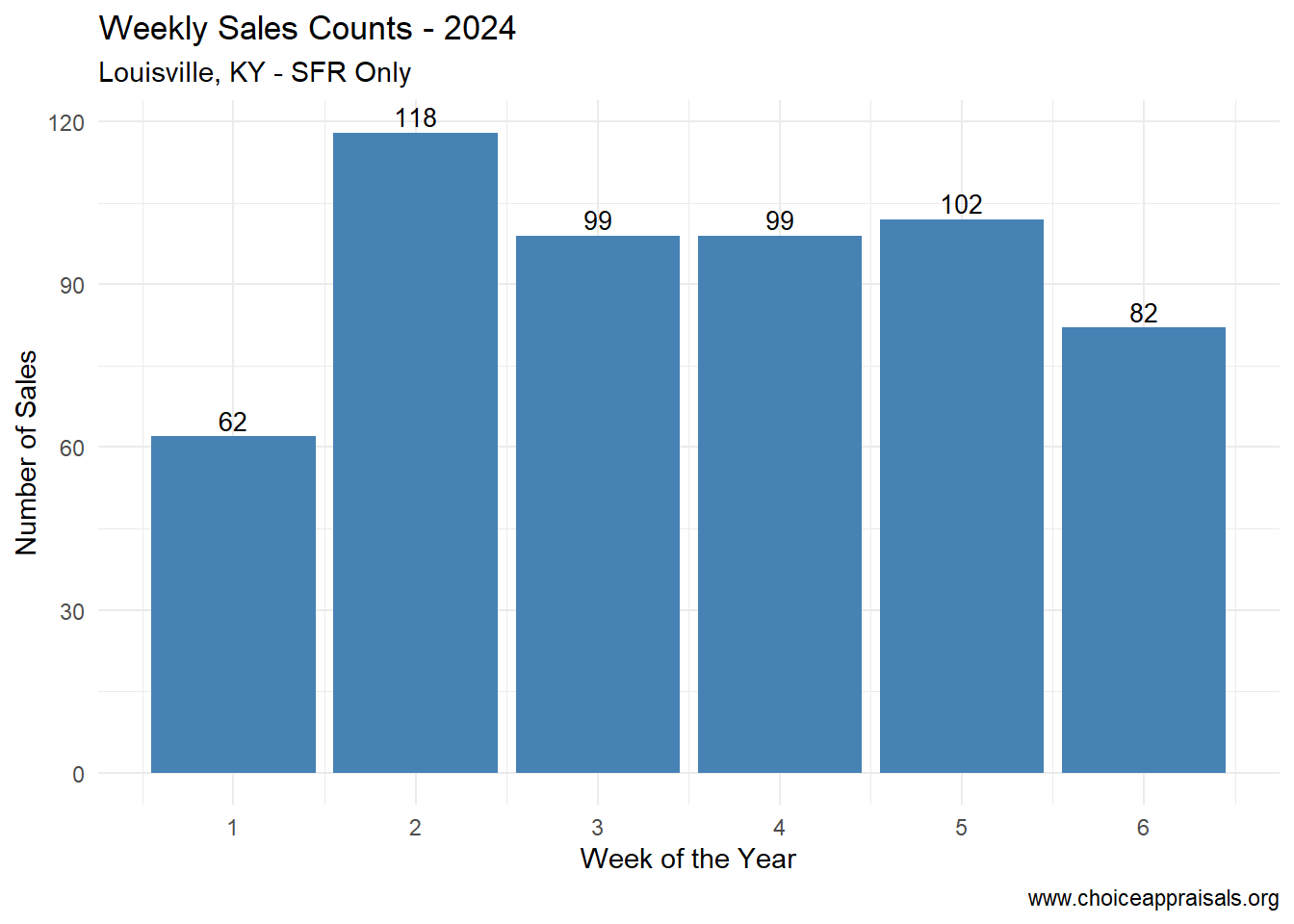
Ups and Downs
The weekly pulse of Louisville’s real estate market beats clearly through the data provided by the MLS. Observing the initial six weeks of 2024, we witness a fluctuating pattern of sales, with peaks that speak to healthy buyer interest and dips that suggest market hesitations. Understanding this rhythm is crucial for anyone looking to enter the market, be it for listing a home or preparing for an appraisal. The key is not just to observe but to act on these insights and to let them help to manage your expectations.
Price Point Precision: Navigating the Sold Price Distribution
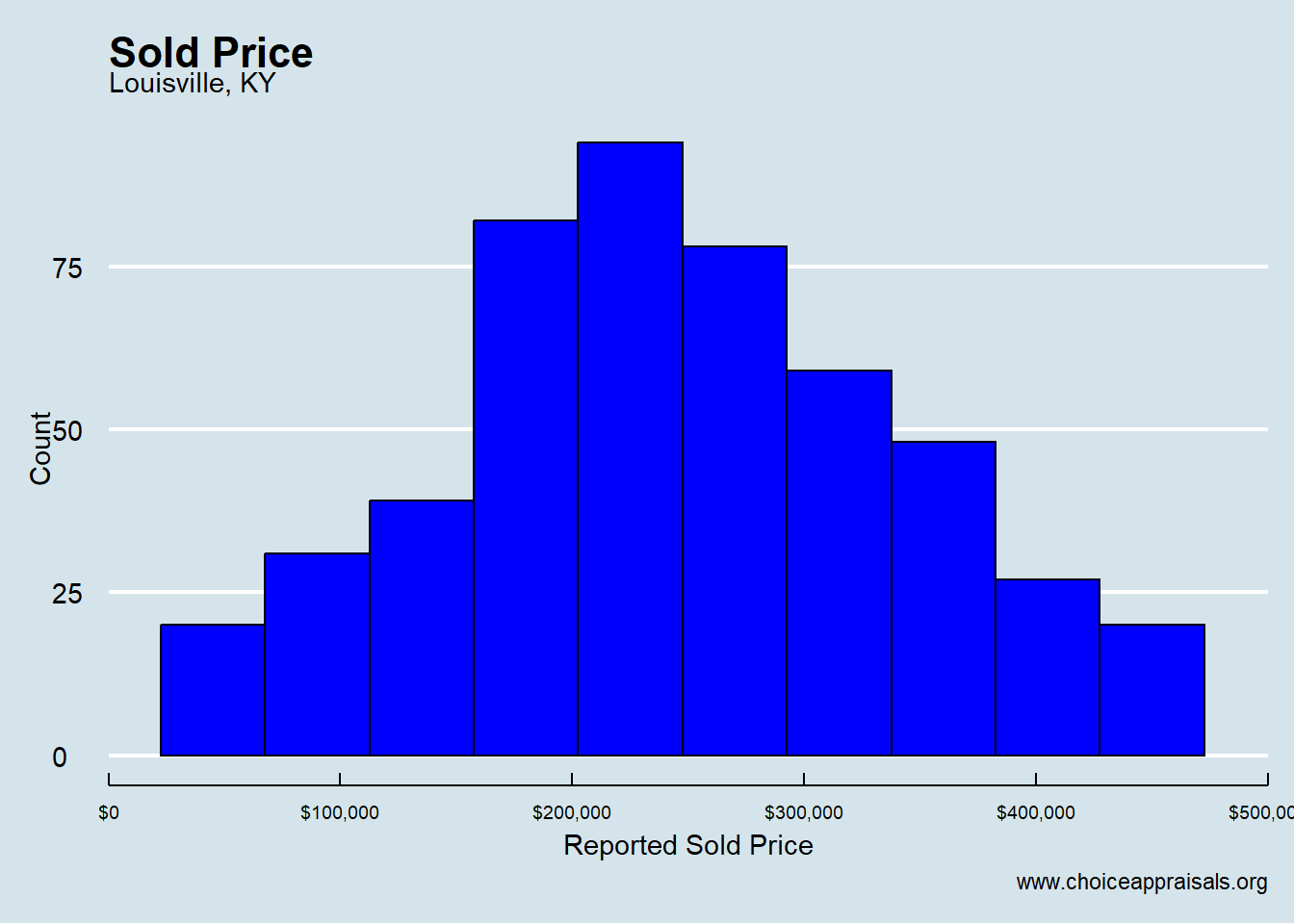
Finding the Sweet Spot
The distribution of sold prices in Louisville (for 1/1/24 – 2/11/24) reveals where the action truly is. Most homes changing hands fall within the $200,000 to $300,000 range, providing a clear target zone for sellers aiming to price their homes competitively. But the market is not one-size-fits-all. Neighborhood-specific trends could shift your home’s position on this spectrum, highlighting the importance of tailoring your strategy to the nuances of your locale.
The Timing of the Sale: Days on Market Analysis
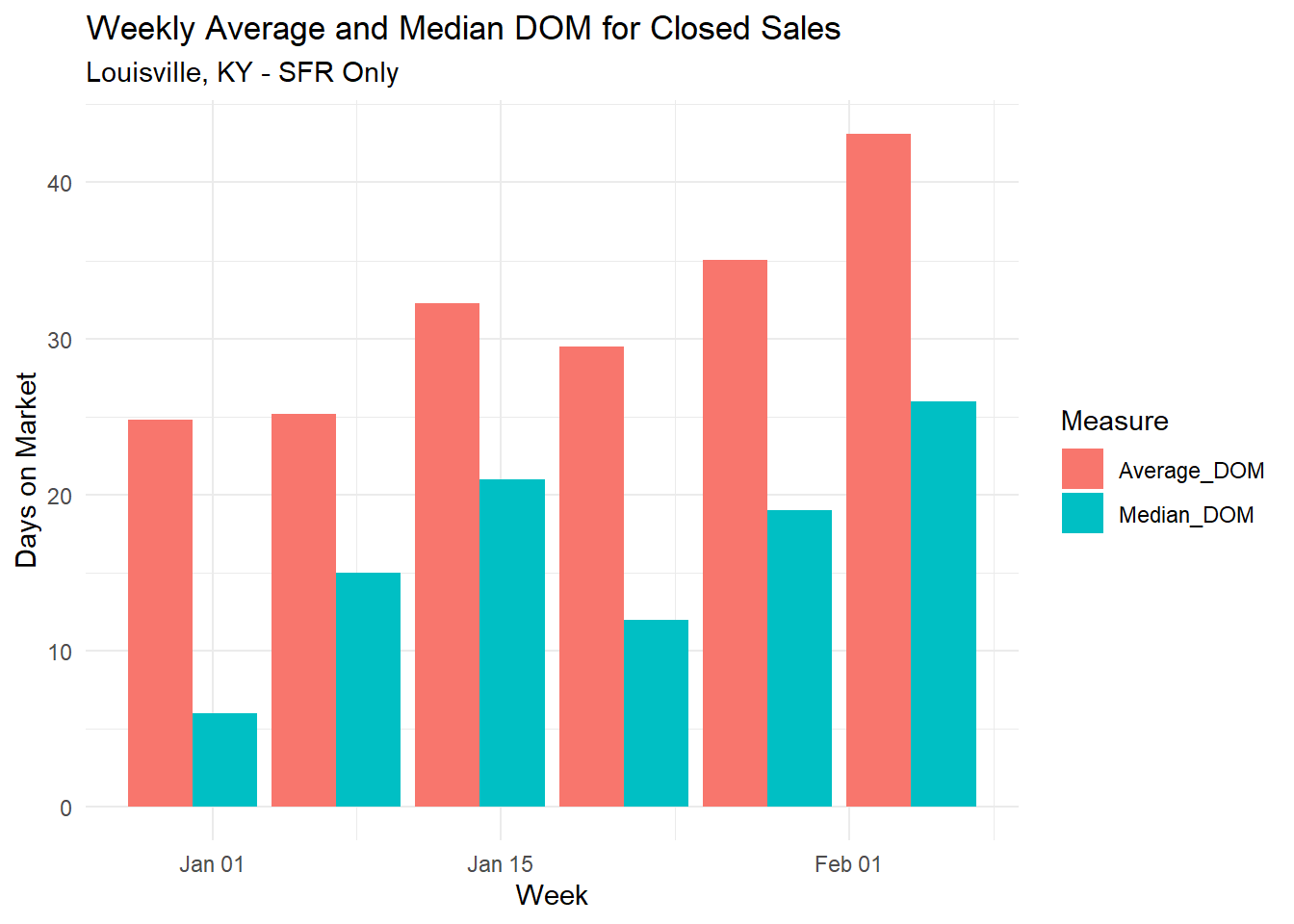
Median vs. Average: A More Accurate Market Tempo
The Days on Market (DOM) chart is a crucial indicator of how swiftly homes are moving in Louisville. Unlike the average DOM, which can be distorted by outliers, the median DOM offers a more faithful representation of what sellers can expect. This distinction is pivotal, as it can shape both the pricing strategy and the marketing approach for your home listing.
Understanding the complex layers of the market goes beyond the surface numbers. By dissecting data, real estate professionals can detect micro-trends that influence broader market movements. For example, a sudden increase in the DOM may indicate a shift towards a buyer’s market, necessitating a more aggressive marketing approach or a reassessment of pricing strategies.
The Art of Negotiation
A deep understanding of market data not only empowers realtors to provide exceptional service but also equips homeowners to engage in informed negotiations. Knowledge of the median sold prices and DOM empowers homeowner to enter negotiations with realistic expectations and the confidence to make or accept offers that are in line with market dynamics.
Real-Life Success Stories: Data-Driven Decisions in Action
When appraising a home in Louisville, a family learned firsthand the power of market knowledge. They needed to sell their mother’s home and got a low offer. With my help, they saw that homes in her area were selling fast, often in less than a month. So, they didn’t have to take the first offer that came along. By setting a competitive price that matched what other homes were selling for, they were in a strong position to sell quickly and for a better price. This real-world example shows why it’s smart to understand the local real estate scene before setting a price or accepting an offer.
Adapting to Market Shifts: Staying Ahead of the Curve
The ability to adapt to market shifts is what sets apart successful real estate professionals and savvy homeowners. Regular analysis of sales counts, price distributions, and DOM trends helps anticipate market changes, allowing for proactive rather than reactive strategies.
In wrapping up our comprehensive analysis of Louisville’s real estate market, we’ve uncovered the profound impact of data on every facet of real estate transactions. By adhering to Stephen Covey’s timeless principle and applying it to the interpretation of market data, we’ve demonstrated how it can lead to more strategic and successful real estate decisions. From the valuation of a property to the intricacies of listing and negotiating, a data-driven, seek first to understand approach is not just advantageous—it’s indispensable. The market speaks a language of numbers and trends; fluency in this language is what leads to confident, informed, and successful outcomes.































